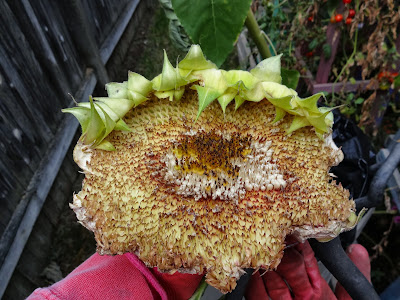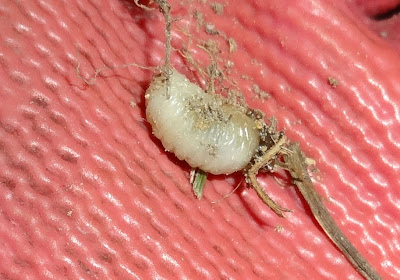Wednesday, December 25, 2013
Tuesday, December 24, 2013
Monday, December 23, 2013
Sunday, December 22, 2013
Saturday, December 21, 2013
Thursday, December 19, 2013
Tuesday, December 17, 2013
Tuesday, December 10, 2013
Bird Bath Heater is Working
At -7 degrees, still ice-free. Birds need a source of water when it's cold so they can take a sip every now and then.
Tuesday, November 26, 2013
Monday, November 18, 2013
My "Christmas Cactus" is Really a Thanksgiving Cactus
And not just because it's blooming now, just in time for Thanksgiving. There are many different types of this cactus. Thanksgiving cactus has flat leaves with serrated edges, and the flower looks like a bird in flight. Christmas cactus has smoother-edged leaves and they tend to spill over the edge of a planter, like a vine. The flowers are more like full, layered trumpets. Thanksgiving cactus above. Christmas cactus below. See the differences?
Labels:
Boise,
Christmas Cactus,
garden,
Idaho,
Thanksgiving Cactus
Saturday, November 2, 2013
Gerber Daisy
November 2nd and these sweet Gerber daisies are still thriving...in a planter with a little shelter.
Saturday, October 26, 2013
Saving Zinnia Seeds
If you live in the Boise area, our dry spell means zinnia seed-saving is easy. Clip off dried flowers. Pull each petal off and you'll see the seed at the end. Snap off petals to save space when storing. You can leave them on, too. I put the seeds in a small paper bag. Be sure to label your seed. The zinnias in the photo are from a State Fair Mix. They generally produce true seed, but it's possible they could have been cross-pollinated with other zinnias. Four seeds heads is plenty for the next season. I'll leave the rest of the seed heads so the birds have food during the winter.
Labels:
Boise,
flower,
Idaho,
seed-saving,
zinnia
Sunday, October 20, 2013
Thursday, October 17, 2013
Monday, October 14, 2013
Composting Surprise
I started composting about a year ago. I put together two bins. One was "hot" and one was a holding bin I planned to start cooking when the other bin was just about done. Above is a photo of the holding bin. The surprise is that the holding bin is just about done - without me trying to get it "cook," by adding nitrogen and stirring and keeping moist. That plastic cup says "compostable" - but as you can see, it hasn't. I'll bury it and try again.
Here is finished compost from the pile I thought was the only one really "cooking."
Now, it starts all over again.
Friday, October 4, 2013
Saving Begonias for Next Season
What are you going to save for the spring? I will attempt three "saves." Begonias, black and blue salvia and fuchsia. First, the begonias. I grew "angel wing" begonias in outdoor planters. Sure, I could probably dig up the entire plants and bring them in, but space is an issue. So I took stem cuttings. I cut about 1/4 inch below a "nodule." Then trimmed all the leaves and flowers off except for two leaves near the top. I placed them in pots prepared with "sponge wet" potting soil, and popped them into plastic bags. I puffed in a little air before sealing and set the bags in an area with indirect sunlight. They should start growing roots in a few weeks, and probably sending out new leaves. Their care will change when that happens. By the way, some people use rooting hormone for stem cuttings, but angel wing begonias are so easy to grow from cuttings, it's not required. Others put stem cuttings in a glass of water. It's important to note, however, that the roots that grow in water are not "true roots." Trim them by about 2/3 before putting in potting soil.
Wednesday, October 2, 2013
Neglected Compost Bin
My compost bin was ignored for about a month and this happened. It was overflowing with tomato and cucumber plants. Oops. But I take it as a sign that the pile is full of nutrients.
Tuesday, October 1, 2013
Last Flower Blast of the Season
The chrysanthemums are putting on a show. In my yard, I consider these the "farewell to the season" flowers. Average first frost date is the first week in October for my zone.
Labels:
Boise,
chrysanthemum,
garden,
gardening,
Idaho
Sunday, September 29, 2013
Saturday, September 28, 2013
Squash Harvest Day
Left to right: Cinderella pumpkin, regular pumpkin, overgrown summer squash and a WTH. It's oblong and large and pumpkin-ish, but not what I planted?
Labels:
Boise,
Cinderella pumpkin,
garden. squash,
Idaho,
pumpkin
Monday, September 23, 2013
Finally. Tomatoes.
Latest tomato season I can remember. And it will be short. The first hard frost is traditionally during the first week of October.
Monday, September 16, 2013
Gaura - Beeblossoms
This plant has long stems and, usually, pink flowers. Some plants have white flowers. When I was a kiddo, we called them beeblossoms. Hummingbirds sip from the flowers, too.
Thursday, September 12, 2013
Saturday, September 7, 2013
Volunteer Petunia
I've been on a "petunia ban" for 4 years now, because of terrible budworm infestations....but somehow, this plant "planted" itself.
Friday, September 6, 2013
Wednesday, September 4, 2013
Every Yard Needs Zinnias
Throw the seeds out there and they bring you bright flowers that are resistant to disease and most pests, while they attract "good guys."
Labels:
Boise,
garden,
hummingbird,
Idaho,
zinnia
Tuesday, September 3, 2013
Bad Things Happening in my Garden
Yikes! I usually share pictures of beautiful things in my garden, but here are two ugly things that have shown up recently. Above is a leaf spot problem on a cucumber plant. I suspect it's anthracnose. Below, powdery mildew on pumpkin leaves. Treatments are available for both. I won't treat the cucumber plant, though. I will pull it up and discard it. The pumpkin plant has already produced two giant fruits, so I'll clip off the infected leaves and treat the other leaves with a preventative containing sulfur (stinky).
Labels:
anthracnose,
Boise,
cucumber,
garden,
gardening,
Idaho,
powdery milder,
pumpkin
Sunday, September 1, 2013
Wednesday, August 28, 2013
Cherry Tomatoes
Chocolate cherry tomatoes on the left, and Sweet 100 cherry tomatoes on the right. They're both good, but definitely different. Less tang in the chocolate version and just like it looks, there are some grape overtones.
Sunday, August 18, 2013
Hollyhocks
I planted seeds last fall, and here we go! I hear I will never have to plant them again because they re-seed freely.
Thursday, August 15, 2013
Spuds are Normal This Year
Dug up some of the potatoes so my daughter could enter hers in the Western Idaho Fair. They look totally normal this year. It took some extra TLC with our extreme temperatures and dry spell. Last year, we didn't pay close attention and wound up with some multi-spud head specimens.
Sunday, August 11, 2013
Monday, August 5, 2013
Squash Blossoms Dropping With No Fruit?
During my shifts in the Ada County Master Gardener lab this year, there have been many questions about squash plants dropping blossoms without bearing fruit. We have had an unusually hot, dry summer, but the reason is more likely the difference between "boys" and "girls." On the left is a male blossom. A female blossom is on the right. The female blossoms have a bulging at the bottom - that's the possibility of baby fruit. Male blossoms do not produce fruit. There are other difference inside the flower structure, just like human boys and girls ;)
See the male and female cucumber examples below.
See the male and female cucumber examples below.
Sunday, July 28, 2013
Hummingbirds Like Blue, Too
While red is the traditional color that attracts hummingbirds, they like blue, too. This one is feeding on black and blue salvia.
Labels:
black and blue salvia,
Boise,
garden,
gardening,
hummingbird,
salvia
Saturday, July 27, 2013
Gooey Eyeballs in the Soil?
Another specimen brought into the Ada County Master Gardener lab - it looks like a rotting bulb. It was found underground, along with a black-topped mushroom-looking thing. The skin on the ball of blob is pinkish, which is a great big clue that this, and the nearby mushroom, are the same thing: a stinkhorn. The stinkhorn mushroom will grow out of this pouch when it's ready, and may grow up to 10 inches tall. It doesn't live very long, thrives in woody material (such as bark chips/wood mulch), isn't harmful, but isn't edible. "Stink" is in the name for a reason. This mushroom thrives on decaying organic matter. Pull and discard the mushrooms if they are bothersome, or if pets or children might be crawling around in them.
Friday, July 26, 2013
Mossy Rose Gall
A wasp did this to a rose bush. The sample showed up this week in the Ada County Master Gardener lab, so be on the lookout for this in your home roses. The gall is caused by Diplolepis spinosa, a cynipid gall wasp. The story is a bit disgusting. The wasps lay their eggs in the stem and the newly-hatched larvae grow inside until they are adults. The plant is tricked into growing the gall to house the babies, stealing nutrients from the plant. A lot of galls can kill the rose. Insecticides aren't an option because they don't work. The galls have to be picked off and disposed of. Check for galls that may have fallen from the plant in autumn.
Thursday, July 25, 2013
Wednesday, July 24, 2013
Tuesday, July 23, 2013
Grubs. Yuck.
It looks like a piece of snot, and that's how I feel about it. Yuck. Blargh. Lawn grubs. I have a couple of dead spots in my backyard lawn, so I did a little digging and found plenty of these squiggly bad guys, munching the lawn to death. Treatment will be a pesticide so they don't ruin the entire lawn.
Monday, July 22, 2013
Balloon Flowers
About a month ago, I was given an unlabeled "perennial." I planted it in my new pollinator garden and what a nice surprise! It's a balloon flower (platycodon).
Labels:
balloon flower,
Boise,
flowers,
garden,
gardening,
platycodon
Saturday, July 20, 2013
Lantana
Lantana is a perennial flowering shrub in warmers areas of the country. For me, it's a superstar annual in a planter.
Friday, July 19, 2013
Mallow Bloom
Mallow is a perennial that grows 4 to 5 feet tall and blooms in mid-July. The flowers are usually white, but this year, they have pink hues.
Thursday, July 18, 2013
Asiatic Lilies
I love this orange version. These lilies were given to me by a neighbor who was re-landscaping part of her yard. I tucked them into the corner of a garden bed.
Wednesday, July 17, 2013
What a Mess - But it's Pretty
Cosmos are the first thing to notice here. I planted them from seed 8 years ago and they re-seed themselves each year. There's also some thyme in bloom, and Kenilworth ivy.
Subscribe to:
Comments (Atom)


















































